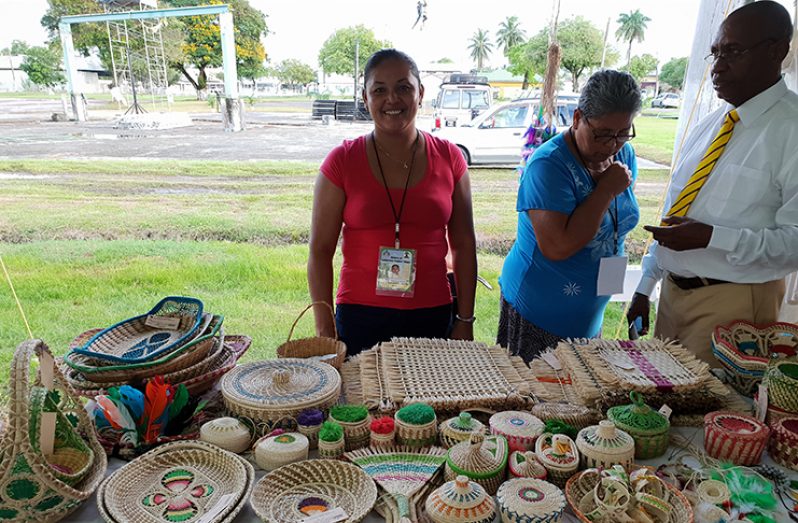By Gibron Rahim
ART and craftwork are but a small reflection of the true richness of Guyana’s Indigenous cultures. However, as the recently concluded Indigenous Food and Craft Exhibition held at the Indigenous Village at Sophia for Indigenous Heritage Month has once again shown, they can also allow us valuable insights into the histories and cultures of Guyana’s nine Indigenous tribes. Among this year’s exhibitors was Janette Patterson of Janette’s Handmade Products.
It was a profusion of colour and a buzz of activity that greeted the Pepperpot Magazine when this publication visited the exhibitors’ booths at the Indigenous Village this past week. Potential customers eagerly moved between the booths, examining the wares on sale with keen interest.
The first sight that drew the eye upon visiting Janette Patterson’s booth was the woven basket decorated with a pattern that included all five colours of Guyana’s flag. Janette is a resident of the Indigenous community of Santa Aratak Village in Region Three. The journey to Georgetown involves crossing the river to Santa Mission followed by travel by boat through the Camuni Creek and then by road for a 25-mile trip from Timehri. Janette travelled the considerable distance to be able to exhibit her products. She told the Pepperpot Magazine that she has been involved in craftwork for over 25 years.
Janette explained that she learned her craft skills from being part of a craft group in the village. That group lasted for a number of years and included the community’s older women who taught their skills to the younger ones. “And now we continue to do it and get more into it,” she said. Presently, the pieces that Janette and her fellow craftswomen create include fruit, bread and floral baskets, jewellery boxes, pans, mats, fans, bags, hammocks and placemats. She noted that the men also create matapees and carve canoes. Different persons, she said, are involved in creating different pieces.
The branches or ‘spires’ of the ite palm that provide the tibisiri straw used to create the woven pieces are obtained from the savannahs. Janette explained that the spires are cut and then stripped of their silken strands. Those strands are then boiled and left to dry in the sun. Noting that the strands are more commonly referred to as ‘straw’, she related that it is the straw that is used to create a range of craft products. The process of obtaining the spires can be time-consuming, taking the men anywhere from half a day to an entire day to gather on a single trip. The following day is then devoted to stripping the spires. The weather also has an impact on the length of the crafting process as the sun’s heat is needed to dry the straw. Additionally, “When the rain steps in it’s difficult for us to get the materials,” related Janette.
Craftwork is one way in which Janette and her fellow artisans celebrate their heritage. She noted that the Food and Craft Exhibition at Sophia is the only one that she is usually involved in, for all five days. She and Janette’s Handmade Products also become involved on occasions when the community opens its doors such as on village days.
Being an artisan and owning and operating her own business, is not without its challenges as Janette noted. Besides the difficulties during the rainy season, Janette noted that one of the greatest difficulties can be waiting for a sale. She related that, once the craftswomen have completed their pieces, the wait is on for a sale. The wait can be discouraging she said as the sales of their pieces are a source of income for the women.
Despite those challenges, the reactions of customers make all the effort worthwhile. “They always commend us,” said Janette. She related that the feedback they receive is usually very positive, as was the case with this year’s exhibition. “Some buy [the products], some don’t,” she stated. Indeed, when the Pepperpot Magazine visited numerous customers were seen milling around, considering their options. As the curtains have come down on another year’s Indigenous Food and Craft Exhibition for Indigenous Heritage Month it can only be hoped that we have gained a greater understanding of our Indigenous cultures, even as we enjoy the food and craft that are reflective of them.




.png)









